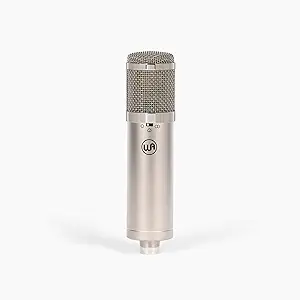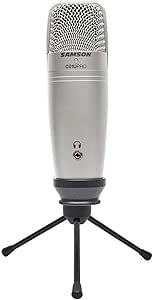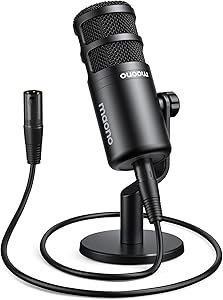Apogee MiC Plus USB Microphone Review Studio-Quality Sound for Musicians and Podcasters
Apogee MiC Plus USB Microphone Review Studio-Quality Sound for Musicians and Podcasters
- Exceptional sound clarity ensures professional studio-quality recordings, even in less-than-ideal acoustic environments.
- The zero-latency monitoring feature allows seamless real-time tracking without delays.
- Compact and portable design makes it convenient for on-the-go recording sessions.
- User-friendly plug-and-play setup eliminates the hassle of complex configurations.
- The robust headphone output delivers clear and balanced audio for precise monitoring.
As an Amazon Associate I earn from qualifying purchases.
Description
Design and Build Quality
Testing out the Apogee MiC Plus was an exciting experience, especially because of its compact and sleek design. The microphone is lightweight, weighing only 1 pound, making it incredibly portable. Its small dimensions—5.02 x 2.13 x 7.8 inches—allow it to fit neatly into any recording setup, be it a desk, a home studio, or even during travel. The build feels solid, thanks to its high-quality electronic components. I appreciated the robust yet minimalist look, which blends functionality with a modern aesthetic. It’s ideal for creators who want professional-grade audio without the bulk of larger mics.
The inclusion of a USB 2.0 hardware interface simplifies connectivity, making it effortless to plug into tablets, smartphones, or computers. The microphone’s corded electric power source ensures consistent and reliable performance, which is crucial during longer recording sessions. For someone like me, who tends to multitask, this mic’s design ticks all the right boxes.
Performance and Sound Quality
This microphone delivers in terms of sound performance. Featuring a professional cardioid condenser microphone capsule, it captures audio with exceptional clarity and precision. While testing, I noticed how the cardioid pattern effectively reduced background noise, focusing solely on my voice. The signal-to-noise ratio of 46 dB ensures that the recordings are clean, even in less-than-ideal environments.
I experimented with different recording scenarios—podcasting, voiceovers, and even some music vocals—and the pure digital connection maintained pristine sound quality. The mic supports 24-bit/96kHz audio resolution, which is a game-changer if you’re looking for studio-quality results. I also found the 46 dB of mic preamp gain to be especially useful for adjusting levels to match the tone and depth I wanted. For anyone serious about audio production, these features are a massive plus.
Ease of Use
One of the key benefits of this microphone is how ridiculously easy it is to set up. It’s a plug-and-play device that requires no tedious configuration. I plugged it into my laptop, and within seconds, it was ready to go. The zero-latency headphone output with a blend feature made monitoring my recordings seamless. Being able to hear myself in real time without delays helped me adjust my tone and delivery instantly.
The mic also works flawlessly with Apogee’s First Take podcast recording application, which supports up to four mics connected to a single computer or USB hub. I tested out the app, and it really does simplify multi-mic setups. It’s perfect for group podcasts or interviews, and the ability to instantly hear recordings once finished is a nice touch.
Positives
This microphone has a lot going for it, and here are some of the favorable attributes I noticed:
- Compact and portable design that fits into any recording setup.
- High audio sensitivity (94 dB) for capturing even subtle sounds.
- Zero-latency monitoring for precise and real-time feedback.
- Plug-and-play functionality—no additional drivers required.
- Compatibility with multiple hardware platforms, including tablets and smartphones.
Shortcomings
While I genuinely enjoyed using this microphone, there are a few areas for improvement:
- The 46 dB noise level might not be ideal in extremely noisy environments.
- It lacks physical buttons or dials for adjusting settings directly on the mic.
- The mic’s price, although justified, may be steep for beginners who aren’t fully committed to audio production yet.
- While the USB 2.0 interface works fine, a USB-C connection would have been a more modern touch.
Market Rivals
Comparing the Apogee MiC Plus to competitors like the Blue Yeti X or Audio-Technica AT2020, I noticed some interesting differences. The Blue Yeti X offers more physical controls on the mic itself, such as gain and mute buttons, but it’s significantly bulkier and less portable. On the other hand, the Audio-Technica AT2020 is a solid choice for studio setups but doesn’t offer the same level of compatibility with mobile devices.
Where the Apogee MiC Plus shines is portability and sound quality. Its zero-latency headphone output is a feature that many competing products lack, and the cardioid condenser capsule ensures professional-grade recordings. However, if you’re after more advanced physical controls, the Blue Yeti X might be worth considering instead.
Bang for the Buck
In terms of price performance, I’d say this microphone is worth the investment if you’re serious about audio quality and need a versatile, portable solution. While it’s not the cheapest option on the market, the features—like pristine 24-bit/96kHz recording and plug-and-play ease—justify the cost. Budget-conscious users might hesitate, but for content creators, podcasters, or musicians looking for reliable gear, this mic offers excellent value for money.
Additional information
| Audio Sensitivity | 94 dB |
|---|---|
| Item Weight | 1 pounds |
| Microphone Form Factor | Lavalier |
| Item dimensions L x W x H | 5.02 x 2.13 x 7.8 inches |
| Power Source | Corded Electric |
| Material | Electronic component (Condenser microphone capsule) |
| SignaltoNoise Ratio | 46 dB |
| Hardware Platform | Tablet, Smartphone |
| Number of Channels | 2 |
| Frequency Response | 20 KHz |
| Noise Level | 46 dB |
| Global Trade Identification Number | 00805676302034 |
| Manufacturer | Apogee Electronics Corp. |
| UPC | 805676302034 |
| Product Dimensions | 5.02 x 2.13 x 7.8 inches |
| Country of Origin | Mexico |
| Item model number | MiC Plus |
| Is Discontinued By Manufacturer | No |
| Color Name | berry |
| Hardware Interface | USB 2.0 |
| Material Type | Electronic component (Condenser microphone capsule) |
| Operating System | \"OS X 10.9 or later; iOS 9 or later, Windows 10\" |













